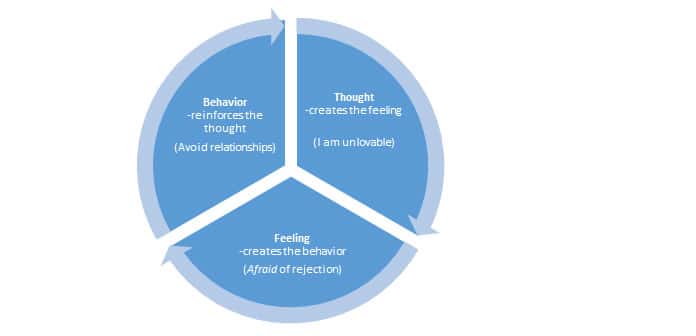Cognitive-behavioural therapy, often referred to as CBT, is an evidence-based treatment approach that focuses on altering the damaging emotions, behaviors and thoughts that cause us distress. Rooted in the belief that our thoughts and perceptions influence our behaviors, CBT works by helping clients identify, challenge and change the initial distressing thought that is maintaining the destructive behavior. For example, let’s take someone who thinks they are unlovable. They may be afraid of rejection and may find themselves avoiding social or romantic relationships. The behavior (i.e. avoiding relationships), then reinforces the thought that they must be unlovable because they have not had a relationship, and the cycle continues.

Over the years, CBT has become increasingly popular and is beneficial in treating depression, anxiety, posttraumatic stress and a variety of concerns. The takeaway from CBT is to help clients understand that although they cannot control every situation, they can control the meaning/significance they place in that situation. Moreover, understanding that two people can hold very different meanings, neither one being ‘right’ or ‘wrong’. There are other kinds of therapies that are highlighted in our Guide to Counselling.
Cognitive Components
A large premise of CBT is the notion of automatic negative thoughts or faulty thinking. These are thoughts that often contribute to, and deepen our emotional pain. They are often intrusive and seem to appear almost instantly in our minds. These are also the thoughts that masquerade as facts, convincing us that something, often negative, is true. There are many types of faulty thinking styles:
All or Nothing Thinking:
When there is no middle ground; things are either perfect, or we’ve failed.
Over-Generalizing:
We take on the results of a single event and apply it to every event; if you fail at one thing, you are a failure at everything.
Mental Filtering:
We dwell on the negative and do not see any other positive experiences or moments.
Disqualifying the Positive:
Similar to mental filtering, however here we simply refuse to acknowledge the good things that have happened or that we have done.
Jumping to Conclusions:
We assume what someone is saying, thinking or feeling about us or our actions.
Catastrophizing:
We blow things out of proportion (typically negative) OR we minimize the importance of something (typically positive).
Emotional Reasoning:
When we believe that what we are feeling in that moment is always true.
Should/Must Thinking:
A list of rules on how to behave that only make us feel terrible; false belief that we can either change the past or be left to feel guilty in the moment.
Labelling:
We assign a negative label to ourselves or others based on a single event.
Personalization:
We take the responsibility and blame for something that is not our fault or entirely our fault.
How does CBT work?
CBT focuses on correcting faulty thinking to, in turn, correct destructive behaviours. For example, we get a bad mark on a test, we’re stupid; we hear a co-worker whispering, they must be talking badly about us and we isolate ourselves; the car did not start this morning, nothing ever goes our way so why bother trying, etc. There are many types of faulty thinking and by listening to the thought, we are more likely to behave in a way that is destructive to our overall wellbeing. CBT examines the thought and assesses its accuracy/validity. We highlight the thought, its attached emotion and put it under a microscope before accepting it as the truth. CBT helps us to understand our faulty thinking styles and the implications they have on our mood. Once we understand something, we have a greater sense of control over it.
Behavioural Component
CBT also recognizes the importance of healthy, productive behaviours and how these can impact our overall wellbeing. Captured by the social learning theory that states the likelihood of one’s behaviour is determined by its consequences (i.e. we are more likely to engage in a behaviour that gives us a sense of accomplishment or pleasure), CBT encourages us to increase behaviors that improve our mood and decrease behaviors associated with a negative mood. This is accomplished through behavioural activation. In CBT, clients are encouraged to keep a record of their behaviours and how they felt during this time. This also gives a tangible and clear representation of the specific behaviour and helps us to take a more objective and realistic look at how it is either helping or hurting our wellbeing. We then can directly associate a behavior and a thought together and create a two-pronged approach for change; alter the behaviour and challenge the associated negative thought.
For more information on counselling in general, see our Guide to Counselling.
